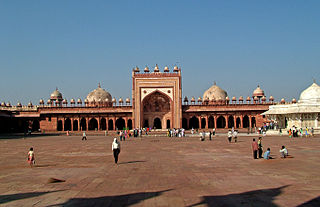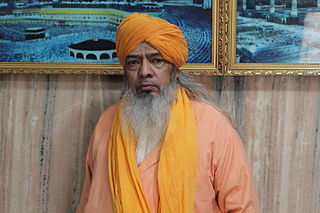
Ajmer is a city in the north-western Indian state of Rajasthan. It serves as the administrative headquarters of the Ajmer district and Ajmer division. It lies at the centre of Rajasthan, earning it the nickname 'the Heart of Rajasthan'.

The Chishti order is a Sufi order of Sunni Islam named after the town of Chisht where it was initiated by Abu Ishaq Shami. The order was brought to South Asia by Mu'in al-Din Chishti in the city of Ajmer.

Fatehpur Sikri is a town in the Agra District of Uttar Pradesh, India. Situated 35.7 kilometres (22.2 mi) from the district headquarters of Agra, Fatehpur Sikri itself was founded as the capital of the Mughal Empire in 1571 by Emperor Akbar, serving this role from 1571 to 1585, when Akbar abandoned it due to a campaign in Punjab and was later completely abandoned in 1610.

Khawaja Syed Muhammad Nizamuddin Auliya, also known as Hazrat Nizamuddin, Sultan-ul-Mashaikh and Mahbub-e-Ilahi, was an Indian Sunni Muslim scholar, Sufi saint of the Chishti Order, and is one of the most famous Sufis from the Indian Subcontinent. His predecessors were Fariduddin Ganjshakar, Qutbuddin Bakhtiyar Kaki, and Moinuddin Chishti, who were the masters of the Chishti spiritual chain or silsila in the Indian subcontinent.

Mu'in al-Din Hasan Chishti Sijzi, known reverentially as Khawaja Gharib Nawaz, was a Persian Islamic scholar and mystic from Sistan, who eventually ended up settling in the Indian subcontinent in the early 13th-century, where he promulgated the Chishtiyya order of Sunni mysticism. This particular Tariqa (order) became the dominant Islamic spiritual order in medieval India. Most of the Indian Sunni saints are Chishti in their affiliation, including Nizamuddin Awliya and Amir Khusrow.

A dargah is a shrine or tomb built over the grave of a revered religious figure, often a Sufi saint or dervish. Sufis often visit the shrine for ziyarat, a term associated with religious visitation and pilgrimages. Dargahs are often associated with Sufi eating and meeting rooms and hostels, called khanqah or hospices. They usually include a mosque, meeting rooms, Islamic religious schools (madrassas), residences for a teacher or caretaker, hospitals, and other buildings for community purposes.

Farīduddīn Masūd Ganjshakar, commonly known as Bābā Farīd or Sheikh Farīd, was a 13th-century Punjabi Muslim mystic, poet and preacher. Revered by Muslims, Hindus and Sikhs alike, he remains one of the most revered Muslim mystics of South Asia during the Islamic Golden Age.

Quṭb al-Aqṭāb Khwāja Sayyid Muḥammad Bakhtiyār al-Ḥusaynī, Quṭb al-Dīn Bakhtiyār Kākī was a Sunni Muslim Sufi mystic, saint and scholar of the Chishti Order from Delhi, India. He was the disciple and the spiritual successor of Mu'in al-Din Chishti as head of the Chishti order. Before him the Chishti order in India was confined to Ajmer and Nagaur. He played a major role in establishing the order securely in Delhi. His dargah located adjacent to Zafar Mahal in Mehrauli, and the oldest dargah in Delhi, is also the venue of his annual Urs festivities. The Urs was held in high regard by many rulers of Delhi like Iltutmish who built a nearby stepwell, Gandhak ki Baoli for him, Sher Shah Suri who built a grand gateway, Bahadur Shah I who built the Moti Masjid mosque nearby and Farrukhsiyar who added a marble screen and a mosque.

Buland Darwaza, or the "Door of victory", was built in 1575 by Mughal emperor Akbar to commemorate his victory over Gujarat. It is the main entrance to the Jama Masjid at Fatehpur Sikri, which is 43 km from Agra, India.

Urs or Urus, is the death anniversary of a Sufi saint, usually held at the saint's dargah. In most Sufi orders such as Naqshbandiyyah, Suhrawardiyya, Chishtiyya, Qadiriyya, etc. the concept of Urs exists and is celebrated with enthusiasm. The devotees refer to their saints as lovers of God, the beloved.

The Urs festival is an annual festival held at Ajmer, Rajasthan, India which commemorates the anniversary of the death of Sufi saint Moinuddin Chishti.

The Sajjāda nashīn or Gaddi nashin is a term of Persian origin, used chiefly within the Sufi traditions of South Asia referring to the successor or hereditary administrator of a Sufi master who typically functions as a custodian or trustee at his shrine.

Nasiruddin Mahmud Chirag-Dehlavi was a 14th-century mystic-poet and a Sufi saint of the Chishti Order. He was a disciple of Sufi saint Nizamuddin Auliya, and later his successor. He was the last important Sufi of the Chishti Order from Delhi.
Khwaja Usman Harooni was an early modern wali or Sufi saint of Islam in India, a successor to Shareef Zandani, sixteenth link in the Silsila of the Chishti order, and master of Moinuddin Chishti. Usman Harooni was born in Haroon, Iran. His year of birth is variously given as 1096, 1116 and 1131 AD. He is also known by the nicknames Abu Noor and Abu Mansur.
Salar Masud or Ghazi Miyan was a semi-legendary Muslim figure from India. By the 12th century, he had become reputed as a warrior, and his tomb (dargah) at Bahraich, Uttar Pradesh, India, had become a place of pilgrimage.

Langar is an institution among Sufi Muslims and Sikhs in South Asia whereby food and drink are given to the needy regardless of social or religious background. Its origins in Sufism are tied to the Chishti Order. During Baba Nanak's Udasi to East Punjab, he saw many people suffering without food due to constant war and loot in the region and established the communal kitchen (Langar) to serve everyone food and shelter regardless of any means of discrimination.

The Jama Masjid is a 16th-century congregational mosque in the UNESCO World Heritage Site of Fatehpur Sikri, located in Uttar Pradesh, India. It was built by Mughal emperor Akbar, and was the largest mosque in the empire at the time of construction. The Jama Masjid's design drew from earlier mosques built by various pre-Mughal sultanates, and served as an important precedent in subsequent Mughal architecture.

Persian Inscriptions on Indian Monuments is a book written in Persian by Dr Ali Asghar Hekmat E Shirazi and published in 1956 and 1958 and 2013. New edition contains the Persian texts of more than 200 epigraphical inscriptions found on historical monuments in India, many of which are currently listed as national heritage sites or registered as UNESCO world heritage, published in Persian; an English edition is also being printed.

Syed Zainul Abedin is the Dewan and Sajjada Nasheen of the Ajmer Sharif Dargah, the Shrine of Khawaja Moinuddin Chishti. He is a Sufi of the Chishti order. He is the son of Dewan Syed Ilmuddin Ali Khan, former Sajjada Nasheen.
The Protocol on Visits to Religious Shrines 1974 is a bilateral agreement between India and Pakistan facilitating Indian and Pakistani nationals to visit certain religious shrines in both countries. As of November 2018, fifteen locations in Pakistan and five in India are covered under this protocol.




























